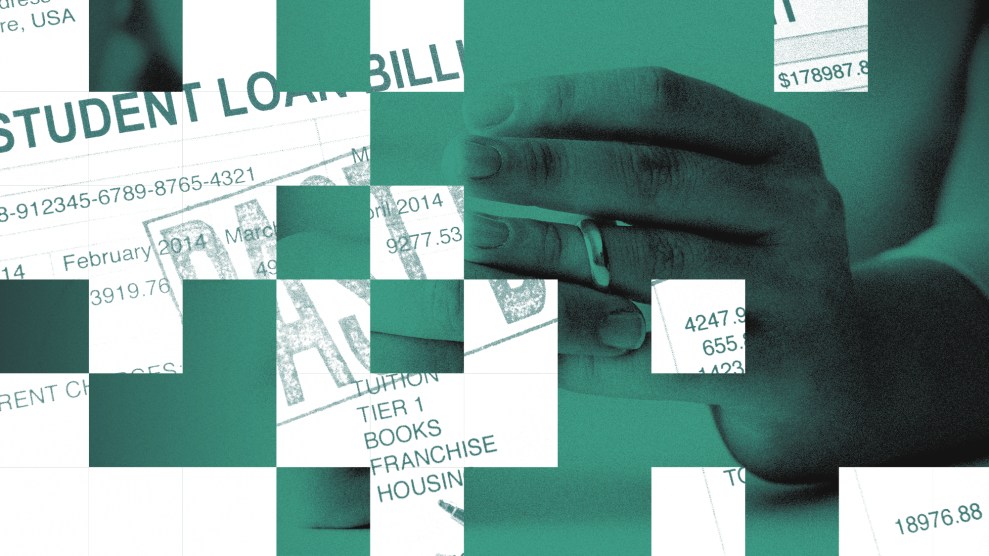
Mother Jones illustration; Getty
When Michelle and her husband divorced, a judge separated their assets. She got the televisions. He got the gas grill and the freezer. Most of their debts were divided and, in many cases, split equally between the two.
But one debt proved more difficult to separate: their student loans. When they were married, they had combined their existing student debt in what is called a spousal consolidation loan. This obscure financial product, which was first made available in 1993 through an act of Congress and was taken off the market in 2006, allowed married couples to turn their separate educational loans into a single, shared liability.
“The pitch was very much, you know, ‘It’ll lower your payments,’” recalls Michelle.
But spousal consolidation loans came with a catch: There is no mechanism to separate the two borrowers’ loans, even after a marriage falls apart. That’s what happened to Michelle, who, according to a complaint she filed in court, had been repeatedly beaten by her then-husband. After he allegedly verbally abused her and threatened to hit her again, Michelle obtained an order of protection against him and filed for divorce. In a legal filing, Michelle’s then-husband denied the abuse allegations.
Michelle, whose name has been changed in this article, was ultimately able to obtain a divorce, but the loans remained consolidated and would become a tether to a relationship she had tried so hard to leave.
The number of people in situations like Michelle’s is relatively small. Mother Jones previously reported that there are only 776 borrowers with spousal consolidation loans that are still being repaid or are expected to be repaid in the future—a small fraction of the 45 million borrowers with student debt. Not all of those 776 borrowers are divorced, but many report issues accessing debt-relief initiatives like the federal program that forgives the loans of people employed in public service-oriented jobs. For those who are divorced, however—and especially for borrowers who experienced abusive marriages—these loans can present particularly distressing challenges.
“This was a very unique product that was created, and the fact that you can’t separate them—I’m not aware of any other product that is designed in this way,” says Persis Yu, policy director at the Student Borrower Protection Center. “They stopped making these loans back in 2006, so these are really old loans at this point.”
Because the law that created spousal consolidation loans leaves both borrowers liable for the entire debt even after a divorce, the former spouses have to “work together in order to make payments,” Yu notes. “Domestic violence is a really big problem with these loans. These loans actually can put survivors of domestic violence in a very precarious situation.”
Michelle says the consolidated debt became a way for her ex-husband to continue to exert control over her life. The divorce decree said that Michelle would be responsible for the loans she accrued for her education prior to consolidation, while the ex-husband would be responsible for the loans he had accrued. But legally, the loans remained a single debt with a single monthly bill, and actually making the payments became a point of contention. Because Michelle was worried about the impact of delinquent debt on her credit score and her career, she felt an obligation to stay current on the payments. But to do that, she needed to interact with her ex-husband.
Michelle’s ex made only some of the payments, she tells Mother Jones. “I would call him and say, ‘Hey, the loan payment’s due. I need to come by and get the payment,’” she says. Sporadically, her ex-husband would give her a check or a money order. Other times, Michelle says, he didn’t make payments at all. “Most of the time, I would try to call, he wouldn’t answer. I would try to text, he wouldn’t answer.” In a legal filing, Michelle’s lawyers alleged that the ex-husband had stopped paying altogether as of 2017, and that in total he had only contributed approximately $1,600 toward the loan following the divorce, while Michelle had paid more than $60,000. In his own filing, Michelle’s ex denied these allegations and asserted that he had paid his portion of the debt.
Eventually, Michelle came to see the lack of cooperation as a continuation of the abuse she says she experienced during her marriage. “I figured out in the last couple years that it was a way for him to abuse, because he still held the cards,” she says. At times, her ex-husband denied ever having student debt in the first place.
“He just flat out told me, ‘Those are yours.’ He would use it to mock me. You know, ‘What are you gonna do? What are you gonna do? You’re not gonna have me anymore to run around and chase around for these loans…What are you gonna do? They’re yours.’ And just was mean. He would call me names.”
A different borrower, Catherine, told Mother Jones that her consolidated student loans also posed a significant challenge. (Catherine’s name, like Michelle’s, has been changed for this article.) Catherine ended her marriage after she learned of an ongoing investigation against her ex-husband for producing child pornography. He eventually pleaded guilty and is currently serving a lengthy prison sentence.
During the marriage, Catherine says, her ex-husband controlled both of their finances and had consolidated the couple’s student loans. He also racked up significant debts for unpaid federal taxes both during and after their marriage, according to tax liens reviewed by Mother Jones. When they were married, Catherine and her ex-husband had filed jointly, meaning that Catherine was held jointly liable for her ex-husband’s tax bills. For the taxes, Catherine said she was able to obtain relief though the IRS’s innocent spouse relief program, which ultimately released her from a significant portion of that debt. By contrast, there is no similar program for spousal consolidation loans and no method to separate the debts.
Currently, Catherine says, she makes monthly payments for both her and her ex-husband’s student loans. The Biden administration’s student loan payment pause didn’t apply to her, she says, because of the type of loan she has. Catherine pays the loans using an income-driven repayment plan, which requires that she certify her income every year. And although her loan servicer allows her to do so without providing information about her ex, Catherine found the process to be traumatic.
“It is emotionally upsetting every time,” Catherine says. “Every year when I have to go through the Income Based Repayment, I have to retell my story…to the loan servicer because they don’t read the notes. And so I have to go through the whole spiel that my ex does not have to sign anything, I don’t have to give you my ex’s income.”
“It’s just very emotional to have to relive that every single year,” Catherine adds, “just knowing I am paying this debt of the person that…harmed me.”
There is bipartisan legislation in Congress that would allow spousal consolidation loans to be separated based on the proportion originally belonging to each borrower. A spokesperson for Sen. Mark Warner (D-Va.) told Mother Jones that he and other co-sponsors “are actively engaged in conversations with our colleagues and are hopeful we can soon move the bill towards its long-overdue passage into law.” Catherine, who has a public service job, says the measure could be life-changing because it could allow her to have her debts wiped out under the public service loan forgiveness program.
The student loans are “the one thing that will haunt me, it’ll hang over my head for the rest of my life unless I can do [the] public service forgiveness program,” Catherine says.
Separating consolidated loans isn’t always as simple as dividing them up based on who initially borrowed how much, particularly for people like Michelle, who says she’s made more payments than her ex-husband has. “I have no idea how they would ever go about separating them,” Michelle says.
Still, Michelle says that getting the loans separated would offer her significant relief, both because she wouldn’t have to interact with her ex-husband and because it might make it easier to get the loans forgiven by the government. “Every time that I have to make a payment every single month, it’s a reminder that I was abused,” she says. “I fought to get out of it. And I’m still tied to it.”

















